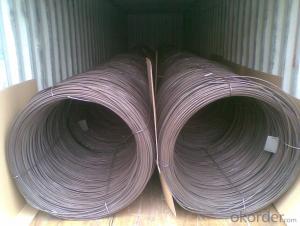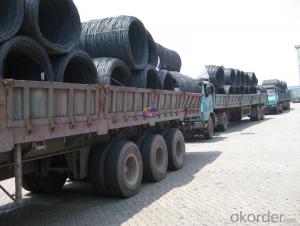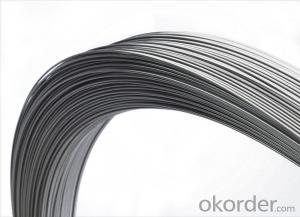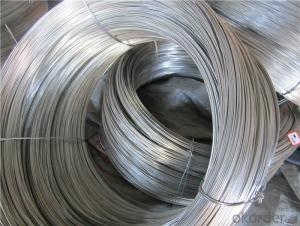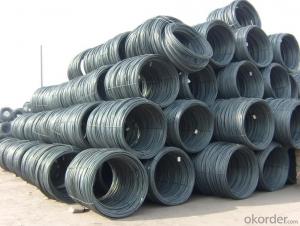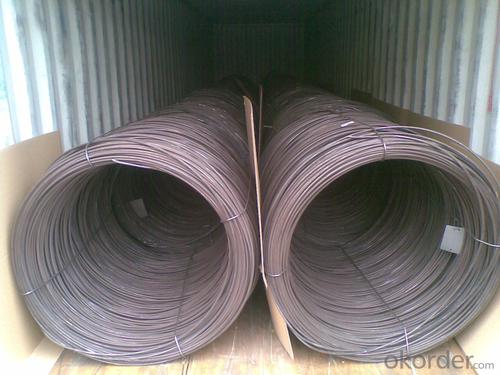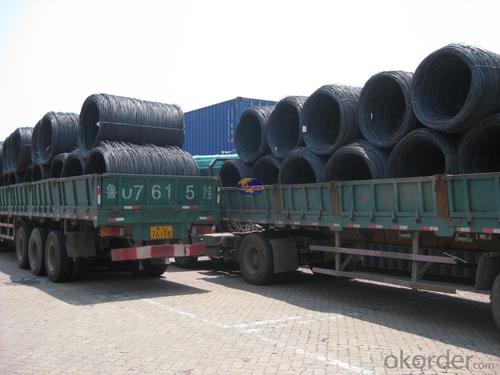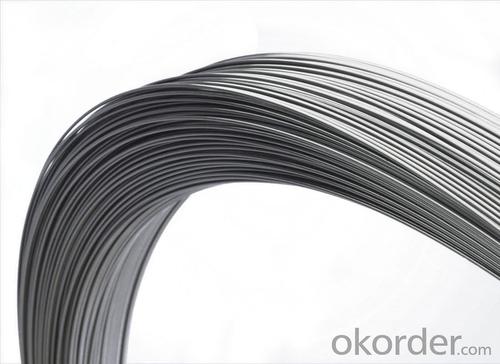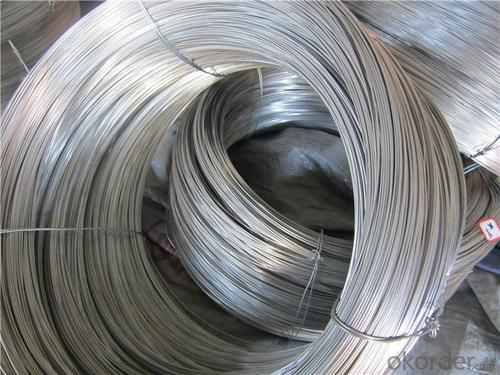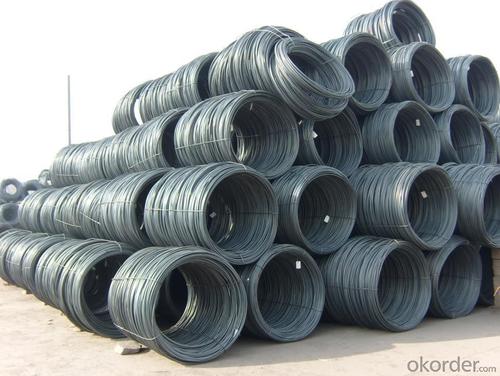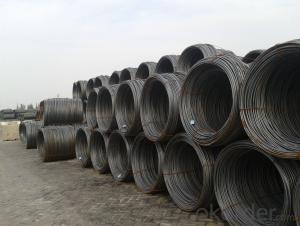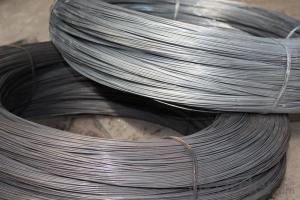SAE1006Cr Carbon Steel Wire Rod 15mm for Welding
- Loading Port:
- Shanghai
- Payment Terms:
- TT OR LC
- Min Order Qty:
- 100 m.t
- Supply Capability:
- 30000 m.t/month
OKorder Service Pledge
OKorder Financial Service
You Might Also Like
Specification
Description of SAE1006Cr Carbon Steel Wire Rod 15mm for Welding:
OKorder is offering Color Coated Steel Coil Prepainted Steel Coil at great prices with worldwide shipping. Our supplier is a world-class manufacturer of steel, with our products utilized the world over. OKorder annually supplies products to European, North American and Asian markets. We provide quotations within 24 hours of receiving an inquiry and guarantee competitive prices.
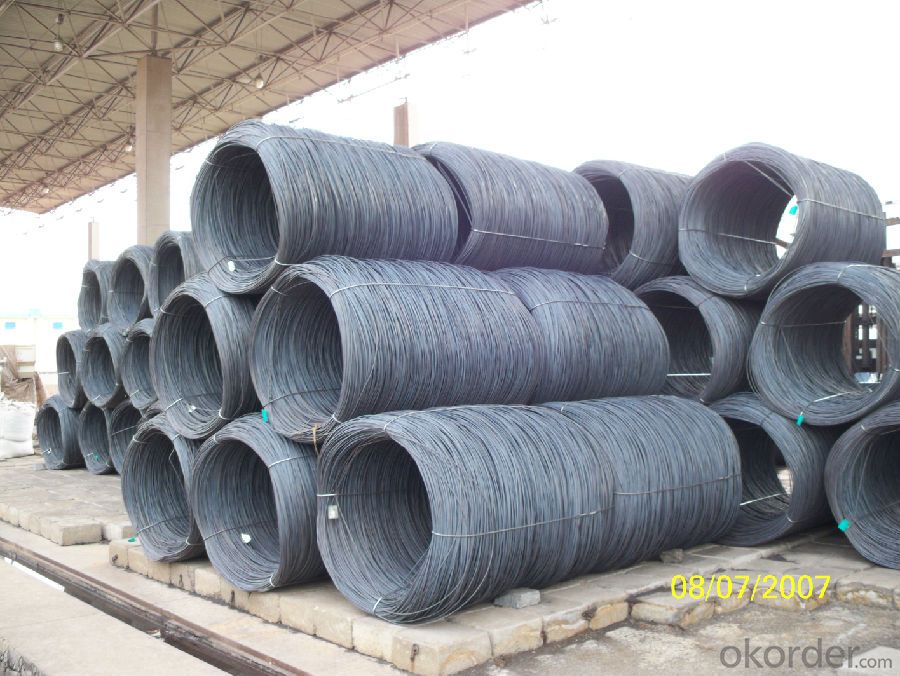
Applications of SAE1006Cr Carbon Steel Wire Rod 15mm for Welding:
Color Coated Steel Coil Prepainted Steel Coil are ideal for structural applications and are widely used in the construction of buildings and bridges, and the manufacturing, petrochemical, and transportation industries.
Main Product Features of SAE1006Cr Carbon Steel Wire Rod 15mm for Welding:
· Premium quality
· Prompt delivery & seaworthy packing (30 days after receiving deposit)
· Corrosion resistance
· Can be recycled and reused
· Mill test certification
· Professional Service
· Competitive pricing
Specifications of SAE1006Cr Carbon Steel Wire Rod 15mm for Welding:
1, Introduction: Color coated steel coils(sheets), i. E. PPGI, also called prepainted steel coils(sheets), are made of galvanized steel coils(sheets) with polymer coatings as surface. It's a new enclosure material and building board with characteristics of light-weighted, heat preserved&insulated, easily installed with bright colors.
2, Production Process: Pretreatment(Degreasing)_Drying_Chromating_Paint Basic Oil_Cooling_Drying_Color Coating_Cooling_Film-covering_Rolling Up
3, Characteristics:
Good at corrosion resistence. Besides zinc coating of the basic plate of galvanized steel sheet, the color coating as the surface has double lifetime to ensure better anticorrosion effect.
With excellent cold bending molded manufacturablity, PPGI products can be processed or directly used as final product. As being light-weighted and conveniently transported, they're widly used to replace wood to save energy.
4.There're thousands of colors can be chosen as per different application. Any color plays well in decoration.
No pollution with high recycling rate, PPGI coils and sheets are strongly recommended as enviroment-friendly products by the government.
5, eye bands and 4 circumferential bands in steel, galvanized metal fluted rings on inner and outer edges, galvanized.
| commodity | SAE1006Cr Carbon Steel Wire Rod 15mm for Welding |
| Techinical Standard: | JIS G3302-1998, EN10142/10137, ASTM A755 |
| grade | Q195,Q215,Q235,SAE1006,SAE1008 SAE1006Cr |
| Types: | Mesh welding |
| Base metal | galvanized, galvalume, cold rolled steel |
| Thickness | 0.14-1.0mm(0.16-0.8mm is the most advantage thickness) |
| Width | 610/724/820/914/1000/1200/1219/1220/1250mm |
| Type of coating: | PE, SMP, PVDF |
| Zinc coating | Z60-150g/m2 or AZ40-100g/m2 |
| Top painting: | 5 mic. Primer + 15 mc. R. M. P. |
| Back painting: | 5-7 mic. EP |
| Color: | According to RAL standard |
| ID coil | 508mm610mm |
| Coil weight: | 2--3MT |
| Package: | Properly packed for ocean freight exportation in 20'containers |
| Application: | Industrial panels, roofing and siding for painting/automobile |
| Price terms | FOB, CFR, CIF |
| Payment terms | 20%TT in advance+80% TT or irrevocable 80%L/C at sight |
| delivery time | 25 days after recepit of 20% TT |
| Remarks | Insurance is all risks |
| MTC 3.1 will be handed on with shipping documents | |
| We accept SGS certificatation test |
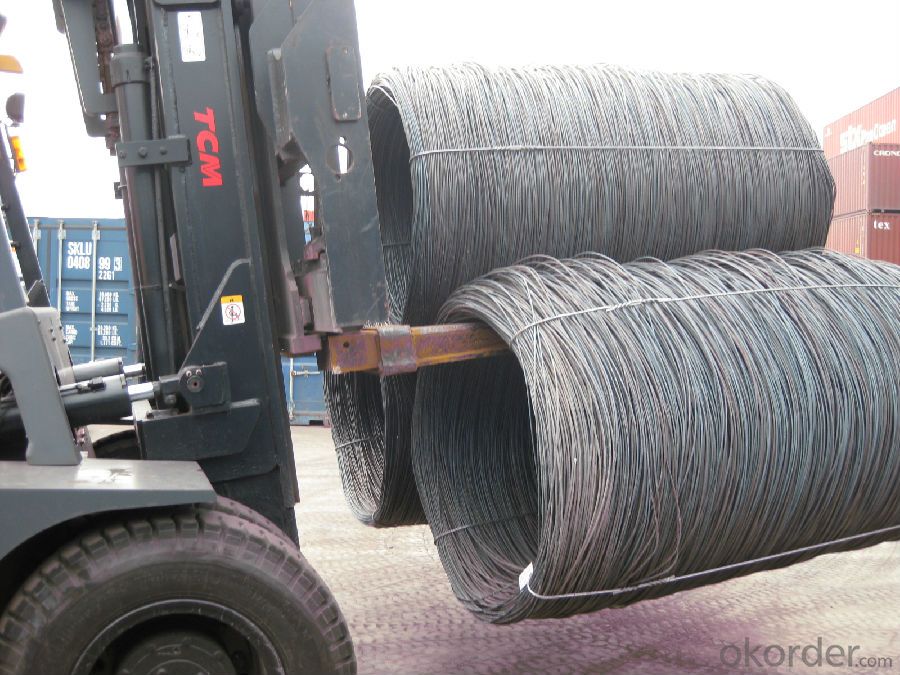
FAQ of SAE1006Cr Carbon Steel Wire Rod 15mm for Welding:
Q1: Why buy Materials & Equipment from OKorder.com?
A1: All products offered byOKorder.com are carefully selected from China's most reliable manufacturing enterprises. Through its ISO certifications, OKorder.com adheres to the highest standards and a commitment to supply chain safety and customer satisfaction.
Q2: How do we guarantee the quality of our products?
A2: We have established an advanced quality management system which conducts strict quality tests at every step, from raw materials to the final product. At the same time, we provide extensive follow-up service assurances as required.
Q3: How soon can we receive the product after purchase?
A3: Within three days of placing an order, we will begin production. The specific shipping date is dependent upon international and government factors, but is typically 7 to 10 workdays.
Q4: What makes stainless steel stainless?
A4: Stainless steel must contain at least 10.5 % chromium. It is this element that reacts with the oxygen in the air to form a complex chrome-oxide surface layer that is invisible but strong enough to prevent further oxygen from "staining" (rusting) the surface. Higher levels of chromium and the addition of other alloying elements such as nickel and molybdenum enhance this surface layer and improve the corrosion resistance of the stainless material.
Q5: Can stainless steel rust?
A5: Stainless does not "rust" as you think of regular steel rusting with a red oxide on the surface that flakes off. If you see red rust it is probably due to some iron particles that have contaminated the surface of the stainless steel and it is these iron particles that are rusting. Look at the source of the rusting and see if you can remove it from the surface.
- Q: How are steel wire rods used in the production of fishing nets for catching fish?
- Steel wire rods are used in the production of fishing nets for catching fish as they provide strength and durability to the net structure. These rods are typically woven or twisted together to form the main framework of the net, ensuring it can withstand the weight and force of the fish caught. Additionally, the steel wire rods help maintain the shape and flexibility of the net, allowing for effective fishing operations.
- Q: What are the main factors influencing the choice of steel wire rod order refund policy?
- The main factors influencing the choice of steel wire rod order refund policy are customer satisfaction, cost implications, and market competition. Customer satisfaction plays a crucial role in determining the refund policy for steel wire rod orders. If customers are not satisfied with the product quality or any other aspect of their order, offering a refund policy can help retain their trust and loyalty. A customer-centric refund policy demonstrates a commitment to resolving any issues and ensuring a positive experience, which can lead to repeat business and positive word-of-mouth. Cost implications also play a significant role in determining the refund policy. Offering refunds can have financial implications for the company, especially in the case of large or frequent refunds. Companies need to carefully assess the potential costs associated with refunds and strike a balance between customer satisfaction and financial feasibility. They may consider implementing certain conditions or limitations on refunds to minimize the financial impact. Market competition is another factor influencing the choice of refund policy. In a highly competitive market, companies may use refund policies as a differentiating factor to attract customers. Offering a more lenient refund policy compared to competitors can give a competitive edge and help in acquiring and retaining customers. On the other hand, if competitors have stricter refund policies, a company may need to align its policy accordingly to avoid losing customers. Overall, the choice of steel wire rod order refund policy is a strategic decision that considers the satisfaction of customers, cost implications, and the competitive landscape. Finding the right balance between these factors is crucial for the company's success in this industry.
- Q: How is steel wire rod used in the manufacturing of wire forms for wind turbines?
- Steel wire rod is a crucial ingredient in the production process of wire forms used in wind turbines. It acts as the primary material that undergoes several processes to become the final wire forms applied in wind turbine applications. To start with, steel wire rod is chosen for its exceptional strength and durability to endure the harsh environmental conditions and heavy loads encountered by wind turbines. Typically, the wire rod is made of low carbon steel, which offers the desired blend of strength and flexibility. The manufacturing process commences with the wire rod being fed into a wire drawing machine. This machine pulls the wire rod through a sequence of dies, gradually reducing its diameter and increasing its length. This operation, known as wire drawing, enhances the wire's mechanical properties, including tensile strength and surface finish. Once the wire has been drawn to the desired diameter, it is ready for further processing. It may undergo additional treatments like heat treatment or surface coating to enhance its properties. Heat treatment can improve strength and flexibility, while surface coating can provide protection against corrosion and abrasion. After the necessary treatments, the wire is then shaped into the desired form for wind turbine components. This can be accomplished through various methods such as bending, twisting, or welding. These shaping processes are critical in creating wire forms capable of effectively supporting and transmitting the mechanical loads experienced by wind turbines. The wire forms manufactured from steel wire rod find applications in various aspects of wind turbines. They can serve as support structures for the blades, offering stability and strength. Additionally, wire forms are employed as electrical conductors, transmitting power generated by the wind turbine to the electrical grid. In conclusion, steel wire rod plays a vital role in the production of wire forms for wind turbines. Its high strength, durability, and versatility make it an ideal material for withstanding the demanding conditions and loads experienced by wind turbines. Through various processes, the wire rod is transformed into wire forms that act as crucial components in wind turbine construction and operation.
- Q: How is steel wire rod used in the manufacturing of tire cords?
- Steel wire rod is an essential component in the manufacturing of tire cords due to its strength, durability, and flexibility. Tire cords are the reinforcing materials embedded within the rubber of a tire, which provide strength and stability to the tire structure. To create tire cords, steel wire rod is first drawn through a series of dies to reduce its diameter and increase its tensile strength. This process, known as wire drawing, ensures that the wire rod meets the specific requirements for tire cord manufacturing. Once the wire rod has been drawn to the desired thickness, it is further processed by a metal coating process. This involves applying a layer of brass or zinc to the wire surface to enhance its adhesion to rubber. The metal coating also protects the wire from corrosion and improves its fatigue resistance, ensuring the longevity and performance of the tire cord. The coated wire rod is then twisted into strands, typically in a helical pattern, to form tire cord yarns. These yarns are then embedded within the rubber matrix during the tire manufacturing process, providing reinforcement and enhancing the tire's structural integrity. The steel wire rod used in the manufacturing of tire cords plays a crucial role in enhancing the strength and durability of the tire. The high tensile strength of steel wire rod allows the tire cords to withstand the immense forces and loads experienced by tires during operation, including acceleration, braking, and cornering. The flexibility of the wire rod also enables the tire cords to conform to the shape of the tire and absorb shocks, contributing to a smoother ride and improved overall performance. In summary, steel wire rod is a vital component in the production of tire cords. Its strength, durability, and flexibility make it an ideal material for reinforcing tires, ensuring their safety and long-lasting performance on the road.
- Q: How is steel wire rod used in the manufacturing of wire for elevator counterweights?
- Steel wire rod is an essential component in the manufacturing of wire for elevator counterweights. The process begins with high-quality steel wire rods, which are typically made from carbon or alloy steel. These rods are subjected to a series of manufacturing processes to transform them into wire that meets the specific requirements for elevator counterweights. Firstly, the steel wire rods are cleaned and descaled to remove any impurities or surface contaminants. This ensures that the wire produced is of the highest quality and has excellent corrosion resistance. Next, the rods go through the process of drawing, where they are pulled through a series of dies to reduce their diameter and increase their length. This process imparts the desired tensile strength and flexibility to the wire. After the drawing process, the wire is usually annealed to relieve any internal stresses and enhance its ductility. This involves heating the wire to a specific temperature and then slowly cooling it. Annealing not only improves the mechanical properties of the wire but also enhances its resistance to fatigue and wear. Once the wire has been drawn and annealed, it undergoes surface treatment processes such as coating or galvanizing. Coating the wire with a protective layer, such as zinc or epoxy, helps to prevent corrosion and extend its lifespan. Galvanizing involves dipping the wire into a bath of molten zinc to create a protective zinc coating, which provides excellent corrosion resistance. Finally, the coated or galvanized wire is further processed to achieve the desired shape and size for elevator counterweights. It can be cut into specific lengths or wound onto spools for easier handling during the manufacturing process. The wire is then used to form the internal structure of elevator counterweights, which are crucial for balancing the elevator car and ensuring its smooth operation. In summary, steel wire rods play a vital role in the manufacturing of wire for elevator counterweights. They are subjected to various processes, including cleaning, drawing, annealing, and surface treatment, to produce high-quality wire with the necessary strength, flexibility, and corrosion resistance. This wire is then used to construct the internal structure of elevator counterweights, ensuring the safe and efficient operation of elevators.
- Q: What are the main factors influencing the choice of steel wire rod order storage tracking options?
- There are several main factors that influence the choice of steel wire rod order storage tracking options. Firstly, the size and complexity of the storage facility play a significant role in determining the tracking options. If the facility is large and has multiple storage areas or racks, it becomes essential to have a comprehensive tracking system that can accurately locate and monitor each order of steel wire rod. Secondly, the frequency and volume of incoming and outgoing orders also impact the choice of tracking options. If the facility handles a high volume of orders on a regular basis, a real-time tracking system that provides instant updates on the status and location of each order becomes crucial for efficient operations. Thirdly, the level of automation in the storage facility is another factor to consider. If the facility is highly automated, with robotic systems handling the movement and storage of steel wire rod, the tracking options should integrate seamlessly with the automation system to ensure accurate and synchronized tracking of orders. Additionally, the specific requirements and preferences of the customers and suppliers can influence the choice of tracking options. Some customers may require real-time updates and visibility into the status of their orders, while others may prioritize cost-effectiveness or simplicity. Similarly, suppliers may have their own tracking systems in place, which need to be compatible with the storage facility's tracking options. Lastly, the overall budget allocated for implementing and maintaining the tracking system is an important consideration. More advanced tracking options, such as RFID or barcode systems, may require higher upfront investment and ongoing maintenance costs. Therefore, the financial resources available will impact the chosen tracking options. In conclusion, the choice of steel wire rod order storage tracking options is influenced by factors such as the size and complexity of the storage facility, the frequency and volume of orders, the level of automation, customer and supplier requirements, and budget constraints. By carefully considering these factors, an appropriate tracking system can be selected to streamline operations and enhance efficiency in managing steel wire rod orders.
- Q: What are the common production processes for aluminum-coated steel wire rod?
- The common production processes for aluminum-coated steel wire rod include cleaning and pickling the steel rod, applying a layer of aluminum through hot-dipping or electroplating, and then undergoing further processes such as drying, cooling, and coiling to create the final aluminum-coated steel wire rod product.
- Q: How is steel wire rod used in the production of wire for mesh filters?
- Steel wire rod is an essential component in the production of wire for mesh filters. The wire rod is first processed through a series of steps to ensure its quality and performance. It is often hot rolled to achieve the desired shape, size, and strength. This process involves heating the steel wire rod to high temperatures and passing it through a series of rollers to shape it into a uniform and continuous wire. Once the wire rod is hot rolled, it is then cooled and further processed to remove any scale or imperfections on its surface. This ensures that the wire is smooth and free from any defects that could compromise the quality of the final mesh filter. The wire rod is then drawn through a series of dies to reduce its diameter and increase its length. This process, known as wire drawing, also helps improve the wire's strength and tensile properties. The drawn wire is then either woven or welded to form the mesh filter. In the weaving process, the wire is interlaced in a crisscross pattern to create a mesh structure. This method is commonly used for finer mesh filters that require high precision and accuracy. On the other hand, the welding process involves joining individual wires together using heat or pressure to create a solid mesh structure. This method is typically used for larger mesh filters or those that require higher strength and durability. The steel wire rod used in the production of wire for mesh filters is crucial as it determines the quality and performance of the final product. The composition and tensile strength of the wire rod are carefully selected to meet the specific requirements of the mesh filter. It is important to use a high-quality wire rod that offers excellent corrosion resistance, durability, and dimensional stability to ensure the longevity and effectiveness of the mesh filter. In summary, steel wire rod plays a vital role in the production of wire for mesh filters. It undergoes various processes such as hot rolling, wire drawing, and surface treatment to achieve the desired properties. The wire rod is then woven or welded to form the mesh structure, which determines the filter's precision, strength, and durability. By using high-quality steel wire rod, manufacturers can produce superior mesh filters that effectively meet the filtration needs of various industries.
- Q: What are the major risks and uncertainties in the steel wire rod industry?
- The major risks and uncertainties in the steel wire rod industry include fluctuations in raw material prices, such as iron ore and scrap metal, which can impact production costs and profitability. Market demand and competition can also pose risks, as changes in consumer preferences or economic conditions can affect the demand for steel wire rods. Additionally, regulatory changes and environmental concerns surrounding the industry's carbon emissions and sustainability practices can introduce uncertainties. Technological advancements and automation may also impact the industry, requiring companies to adapt and invest in new equipment and processes to remain competitive.
- Q: What are the main challenges in steel wire rod production?
- Some of the main challenges in steel wire rod production include maintaining consistent quality and specifications, controlling the dimensions and surface finish of the wire rod, ensuring proper heat treatment and metallurgical properties, managing the high energy consumption and environmental impact associated with the production process, and addressing the global competition and market fluctuations in the steel industry. Additionally, ensuring the safety of workers and optimizing production efficiency are also key challenges in this sector.
Send your message to us
SAE1006Cr Carbon Steel Wire Rod 15mm for Welding
- Loading Port:
- Shanghai
- Payment Terms:
- TT OR LC
- Min Order Qty:
- 100 m.t
- Supply Capability:
- 30000 m.t/month
OKorder Service Pledge
OKorder Financial Service
Similar products
Hot products
Hot Searches
Related keywords
